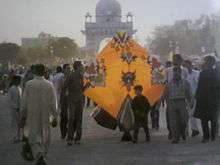Festivals in Lahore
Lahore, being the richest cultural city in Pakistan celebrates a number of festivals throughout the year. It is most popular for the festivals of Basant and Mela Chiraghan, but many others are celebrated in the metropolis as well.
Basant (Jashn-e-Baharaan)


The biggest, or perhaps the best known, festival is that of Basant (or Jashn-e-Baharaan) held in February each year. Basant is a Punjabi festival celebrating the onset of the spring season and is also called the Basant Festival of kites. This festival is celebrated with kite flying competitions all over the city especially in the Androon-E-Shehr (The Inner City or the Walled City) area. The sky is literally filled with colorful kites of all shapes and sizes flown from rooftops. The kites are flown on strings called “Dorr” which is a special thread with cut glass embedded within which serves to cut the thread of competitor kites more effectively. Some of the kite-flying competitions get extremely competitive and serious. Women, on this day are seen wearing a bright yellow dress up to the hilt. This festival gained more and more importance over the years and used to attract people from all over the world.[1] But since 2007, it has been banned.[2]
Mela Chiraghan
Mela Chiraghan or Mela Shalamar (Festival of Lights) is a three-day annual festival to mark the urs (death anniversary) of the Punjabi Sufi poet and saint Shah Hussain. It takes place at the shrine of Shah Hussain in Baghbanpura, on the outskirts of Lahore, Pakistan, adjacent to the Shalimar Gardens. The festival used to take place in the Shalimar Gardens also, until President Ayub Khan ordered against it in 1958.[3] The festival used to be the largest festival in the Punjab, but now comes second to Basant.[4]
National Horse and Cattle Show
The show is held at Fortress Stadium in the third week of November for 5 days. Activities in the event include cattle races, cattle dances, tent pegging, tattoo show, folk music, dances, bands, cultural floats and folk games.
The show has been described as an eloquent expression of Pakistan's heritage and an authentic account of its agricultural and industrial achievement's. The fortress stadium, the venue of the show is thronged by active participants, foreign visitors and peoples who watch the festival with great enthusiasm, verve and aplomb. A large number of them are interested in watching and appreciating the best breeds of livestock. Many derive pleasure by watching other activities such as display parade of animals, dances by horses and camels, polo matches, dog shows and their races, vaudeville acts of stuntmen, mass display of military band, rhythmically physical exercise by the children, decorated industrial floats and torch light tattoo shows. Additional attractions include a subtle interplay of lights to weave enticing patterns at night and breath taking acts by foreign groups. The show began as a modest exhibition organized by the army to project the cattle wealth of the country in the early fifties.
Pakistan is an agricultural country its prosperity depends on agriculture and live stock. Cattle show provides incentives to the formers to develop agriculture and livestock. Cattle show encourages the farmers to graze their animals.
Today it is an international event to which come dignitaries from abroad and visitors and foreign tourists. The organizing committee comprises representatives of a number of agencies including army, rangers, LMC schools, the police, industrialists and the art councils.[5]
World Performing Arts Festival
The World Performing Arts Festival is held every autumn (usually in November) at the Alhamra Arts Council, a large venue consisting of several theatres and amphitheatres. This ten-day festival consists of musicals, theatre, concerts, dances, solos, mime and puppet shows. The festival has an international flavour with nearly 80 percent of the shows performed by international performers. On average 15-20 different shows are performed every day of the festival.[6]
Literature
National
- Pakistan Day (23 March): Military parade takes place to commemorate the anniversary of Pakistan Resolution passed on March 23, 1940.
- Independence Day (14 August): Meetings, processions, rallies, decorations and illustrations.
- Defence Day (6 September): Parades and exhibitions of military equipment. Visits to the war memorials.
- Air Force Day (7 September): Display of latest aircraft of Pakistan Air Force and air shows.
Religious
Others
- The Karakoram Car Rally’s closing ceremonies were first held in Lahore in 2001, and plans are to bring it back to the city in the future. A colorful closing/award giving ceremony was held in Hunza Valley. Prizes, shields, certificates were distributed among the ralliers. SAF-International Karakoram Car Rally was also planned for year 2001, but it was postponed. International Karakoram Car Rally has been proposed to be held during the month of November in 2002 as part of the International Year of Mountains celebrations.[7]
- National Industrial Exhibition Lahore (3rd week of November for 15 days): Held at Fortress Stadium, Lahore. Exhibition and sale of industrial products and handicrafts of Pakistan.[8]
- Punjab Sports Festival, a divisional level annually sports festival.
References
- ↑ Culture versus Religion — Khaled Ahmed Urdu Press Review
- ↑ http://tribune.com.pk/story/114728/kite-makers-fret-over-basant-decision/
- ↑ A Victim of Apathy
- ↑ Mela Charagan
- ↑ Calendar of Events Government of Pakistan: Tourism
- ↑ The Festival
- ↑ Karakoram Car Rally by P.T.D.C
- ↑ Calendar of Events Government of Pakistan: Tourism